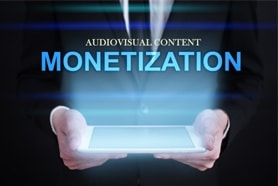Audiovisual Content Monetization: How Ready Are You?
Home » Audiovisual Content Monetization: How Ready Are You?
- June 22, 2016

Television is no more the only go-to entertainment device. According to a report, as viewers consume TV shows and movies in various devices on-the-go, television has lost 13 percent of its viewers in 2015.
With the millennials abandoning television faster than anybody else, broadcasters are aggressively exploring new ways to package content and share it across multiple platforms. Consumers now want more variety and quality content to be delivered to the right device at the right price, which is why providers are looking beyond repackaging the same old content to make it available.
As content becomes the leading online commodity, broadcasters and media organizations are trying to monetize their content. The need to create, convert, and manage digital content has brought forth new technologies, competitive paradigms, and business dynamics in the industry.
Consumers now expect instant access of all content – news, entertainment, corporate, social, media or personal across devices. This has resulted in companies innovating to create ways to monetize content. The biggest challenge that organizations are facing is not technology but the availability of content in the consumable format. If monetization is the immediate priority, content owners need to focus on:
- Digitization of their historic analog content
- Management and optimization of newly produced content
A lot of content still lies in old formats like videotapes or film. Organizations need to convert these to digital files and create relevant metadata and support index to aid effective and seamless content retrieval. To facilitate this, content curators need to assess the audio-visual assets to determine the appropriate platform to store, access and distribute the content. Moreover, content, as an asset, needs to be managed well to ensure optimal distribution across channels to generate parallel revenue streams.
Once digitized and managed well, media asset managers not only undertake the effort to digitize and manage content to ensure easy search and availability, they also present an array of options to monetize the content.
Subscription Plan
Common for all types of digital content, be it gaming, streaming content (like Hulu, Spotify, or Netflix), software, or magazine and newspapers, subscription model primarily use paywalls, through which users subscribe to content for a monthly or annual fee. Broadcasters have the option of implementing paywall after a free trial, immediately on consuming the content, or pay-as-per-use. Some content is also charged after a specific number of views, which allows broadcasters to generate revenue from ad.
Transaction Plan
Consumers have access to digital content after paying a one-time transaction fee, where they pay-to-own the track, movie, image, or article, or pay multiple times as they use the content. Multiple transactions allow users to have time limited access of content and applications. iTunes and YouTube movies are examples of content being available in this model.
Freemium Plan
Under this plan, content is offered for free, while the broadcasters charge premium for selective content. For example, Angry Birds game is available for free, but users need to pay for an ad-free version or to purchase goods and levels within the game.
Ad-support Plan
Common across digital verticals, ad-supported free content earns revenue from ads, like banner or C. While content is provided free, advertisers use the platform to run ad campaigns and pays the content owner for using the platform.
While organizations try different plans across different platforms to broadcast and monetize content, what needs to be kept in mind is one-size-fits-all doesn’t work for all content owners. Media asset managers and broadcasters need to identify the ideal plan that suits the overall business objectives of the organization.
[1] https://www.accenture.com/us-en/insight-digital-video-connected-consumer

